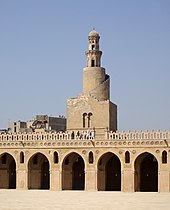Ibn Tulun Mosque
The Ibn Tulun Mosque ( Arabic مسجد ابن طولون Masdschid ibn Tūlūn , DMG masǧid Ibn Ṭūlūn ) is the largest mosque in Cairo and is considered to be the oldest preserved mosque in the city in its original form. The even older Amr Mosque was significantly rebuilt.
Building history
The mosque was built from 876 to 879 under Ahmad ibn Tulun , who as governor of the Abbasid caliphs ruled over Egypt between 868 and 884 and led the country to de facto independence. The start of construction was dated by the Egyptian historian al-Maqrizi (1364–1442), the completion is recorded on an inscription plate on the mosque.
The mosque was built on the small Gebel Yaschkur ("Hill of Thanksgiving"). A local legend claims that Noah's Ark touched down here after the Flood and that the roofs that were preserved were built from their wood.
The mosque formed the center of the emerging capital of Ibn Tulun, Al-Qatta'i, not far from Fustat , from which the empire of the Tulunid dynasty he founded was ruled. The mosque was originally located next to Ibn Tulun's palace, from which a door next to the minbar gave him direct access. Al-Qatta'i was destroyed in the early 10th century, the mosque is all that remains.
The mosque was built in the Samarra style, combined with an Abbasid structure. It consists of a covered hall gallery surrounding the inner courtyard, with the largest hall facing towards Mecca in the Qibla direction . The original mosque had its ablution well ( sabil ) in the area between the inner and outer walls. In the 13th century, Sultan Ladschin had another sabil with a high domed roof added to the central courtyard.
minaret
The time of erection of the minaret is controversial, the outer staircase is based heavily on the minaret of Samarra . A legend claims that Ibn Tulun designed it himself: while sitting with his officials, he absent-mindedly wrapped a piece of parchment around his finger. When someone asked what he was doing, he replied, embarrassed that he was designing his minaret. However, many of the architectural features point to a later construction, especially the lack of connection to the mosque's floor plan. In the earliest description by the Arab geographer al-Muqaddasi (945 / 6-1000), the minaret has an external staircase, al-Maqrizi mentions the similarity to the minaret of Samarra. The architectural historian Doris Behrens-Abouseif, however, suspects the Sultan Ladschin , who restored the mosque in 1296, as the builder of the minaret.
Restorations
The mosque has been restored several times. The first known restoration was carried out in 1177 on behalf of the Fatimid vesir Badr al-Jamali , who had a second inscription plate attached to the mosque. Thereupon the unity of God and the prophethood of Muhammad are confirmed, but also the adherence to the Shia version of the Shahada with the statement "and Ali is the ally of God" is required. The restoration by Sultan Ladschin of 1296 added some improvements. The mosque was last restored in 2004 by the Egyptian Antiquities Authority .
During the Middle Ages, some houses were built right on the outer wall of the mosque. Most were demolished in 1928 by the Committee for the Preservation of Arab Monuments, but two of the oldest and well-preserved patrician houses were left standing. The Beit Al-Kritliyya ("House of the Cretan Woman") from the 17th century and the Beit Amna bint Salim from the 16th century were originally two separate buildings, which were later connected by a bridge on the third floor. The two houses are accessible via the mosque courtyard and include the Gayer-Anderson Museum . The museum is named after the British Major Robert Grenville ("John") Gayer-Anderson, who lived there until 1942, and contains parts of his private collection.
Others
The west side of the inner courtyard of the Ibn Tulun Mosque with the minaret is depicted on the front of the Egyptian 5 pound banknote .
Parts of the James Bond film The Spy Who Loved Me were filmed at the Ibn Tulun Mosque and in the rooms of the Gayer Anderson Museum.
Individual evidence
- ↑ al-Maqrīzī, Ḫiṭaṭ , II, p. 265 ff.
- ^ RG 'John' Gayer-Anderson Pasha: Legends of the House of the Cretan Woman. American University in Cairo Press, Cairo 2001, pp. 33-34. / Nicholas Warner: Guide to the Gayer-Anderson Museum in Cairo. Press of the Supreme Council of Antiquities, Cairo 2003, p. 5.
- ↑ Tarek Swelim The minaret of Ibn Tulun Reconsidered. In: Doris Behrens-Abouseif (Ed.): The Cairo Heritage. The American University in Cairo Press, Cairo 2000, p. 79
- ^ Doris Behrens-Abouseif: Islamic Architecture in Cairo: an introduction. EJ Brill, Leiden and New York 1989. p. 55.
literature
- Nicholas Warner: The Monuments of Historic Cairo: a map and descriptive catalog. American University in Cairo Press, Cairo 2005.
Web links
- Mosque of Ibn Tulun - 3D Virtual Tour
- complete representation of the mosque at Archnet (English)
- M. Tarek Swelim: The minaret of Ibn Tulun Reconsidered. In: Doris Behrens-Abouseif (Ed.): The Cairo Heritage. The American University in Cairo Press, Cairo 2000 (PDF file; 2.24 MB)
Coordinates: 30 ° 1 ′ 43.5 ″ N , 31 ° 14 ′ 58.3 ″ E




